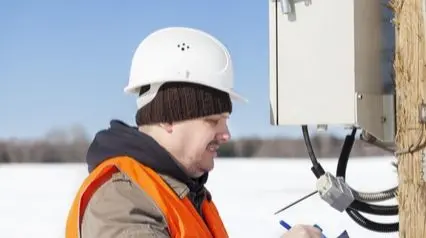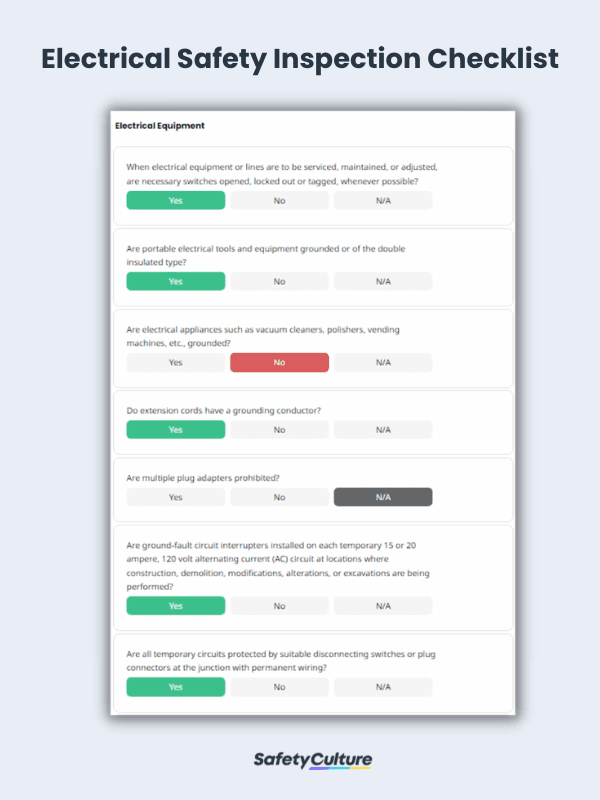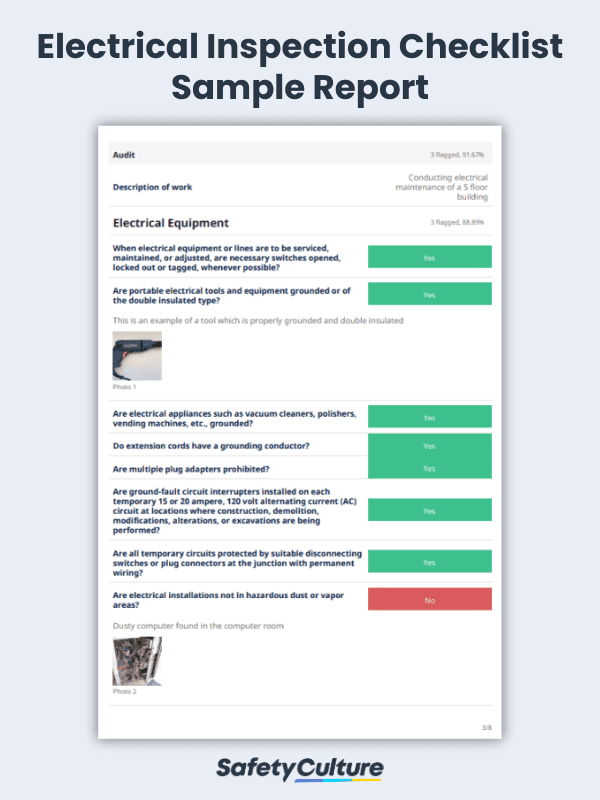What is an Electrical Inspection Checklist?
An electrical inspection checklist is an essential tool to determine if your workers and worksite conditions adhere to electrical compliance safety rules. Electrical equipment should undergo quality and safety checks before operating. Inadequate checks and poor training can lead to serious electrical injuries and fatalities.
What do Electrical Safety Checks Involve?
An electrical safety checklist accompanies a site walkthrough to identify and report on common electrical hazards. This involves checking if safety barriers and signs are in place, ensuring that tools and equipment are in pristine condition, and looking for exposed wiring that needs proper guarding mechanisms among others.
Top 3 Reasons to Perform Electrical Inspections
An electrical inspection is performed by a qualified person who is trained and knowledgeable in the construction and operation of electrical systems. It helps to identify unsafe equipment, faulty installation, and unfollowed work practices. Here are the key reasons why you should perform electrical inspections:
1. To Keep Electrical Hazards at Bay
OSHA recorded that electrocution is the most common hazard and one of the fatal 4 across the construction industry (e.g., during the post-construction cleaning process). Performing electrical inspections help prevent electrical hazards in the workplace and ensures a safe environment for all employees.
2. To Ensure Compliance with Regulatory Standards
Businesses need to comply with regulatory standards to prevent unnecessary incidents, lawsuits, and criminal investigations. Complying with OSHA’s electrical standards helps to protect employees from exposure to danger such as electric shock, electrocution, fires, and explosions.
3. To Secure Insurance Claims
Insurance companies require evidence to support insurance claims. Accurate record-keeping serves as a record in the event of incidents and damages. It substantiates the facts that you have gathered during the electrical inspection.
Developing an Electrical Maintenance Checklist and Plan
Electrical safety inspections are an essential part of an overarching electrical maintenance plan. Coming up with an effective electrical maintenance checklist and plan requires the following resources:
A dedicated team and budget
An in-house facilities team must have at least one electrician, maybe more depending on the size of the building and how much equipment and wiring is involved in its operation. Allocating sufficient funds to the facilities team to cover electrician salaries, including maintenance tools, and equipment, is the first step to having an effective electrical maintenance plan.
Knowledge of the specific electrical equipment on-hand
While almost all equipment and facilities used in business operations are powered by electricity, not all of them work the same way. For example, fuses and circuit-breakers need to match the circuits they are protecting so they can effectively stop electrical overloads when they occur. Knowing the working details of your operation’s electrical equipment is a must since electrical maintenance plans should be tailored in order to be effective.
Back-up equipment and materials for necessary repairs and replacements
Finding out what needs fixing and replacing is half the electrical maintenance plans’ job. The other half is actually fixing and replacing the electrical equipment critical to the continued operation of the business. For this reason, an inventory of back-up equipment and materials must be available so the necessary repairs and replacements can be done as soon as potential problems are identified.
A regular electrical maintenance schedule
In most business operations, electrical equipment and wiring are constantly at work. After sufficient wear and tear, dangerous electrical malfunctions are more likely to occur. A regular electrical maintenance schedule must be established and diligently followed in order to identify dangerous instances of equipment and wiring damage before they cause accidents that can lead to injuries or fatalities.
Complete, easily accessible electrical maintenance logs
Each time a scheduled or ad-hoc electrical maintenance check is done, electricians and other maintenance personnel must record and document their findings and observations. Prior to performing the subsequent electrical maintenance check, they must consult the previous maintenance check’s observations and notes to inform their inspection. This is why a complete database of easily accessible electrical maintenance logs must be maintained.
How to Conduct an Electrical Inspection Using a Checklist
An electrical inspection requires a thorough assessment of electrical equipment, surroundings, and other factors that may result in an electrical hazard. Some inspections may require evidence through captured photos or videos.
To start with the electrical inspection, use this checklist as a guide:
- Enter basic information about the site and the personnel conducting the inspection.
- Check if all electrical equipment is maintained and in good working condition.
- Assess surroundings whether they are a risk or at risk of electrical hazards.
- Ensure that safety procedures are practiced by other employees.
- Double-check if lockout tagout procedures are followed.
- Summarize with an overall assessment of the workplace.
- Add recommendations, action points, or other notes regarding the inspection.
Frequently Asked Questions (FAQs) about Electrical Inspections
The frequency of electrical inspections varies based on factors like property type and local regulations. For most residential homes, it’s recommended to have an inspection every 10 years, but immediate inspections are necessary if any electrical issues arise. Commercial and industrial buildings typically require inspections every 3 to 5 years due to higher electrical demands.
Yes, government regulations do exist regarding electrical inspections in many regions, aiming to ensure the safety and compliance of electrical systems. These regulations typically cover the following:
- Frequency of inspections for different property types
- Certification requirements for inspection professionals
- Adherence to recognized electrical codes and standards like the National Electrical Code (NEC)
- Reporting of findings
- Safety standards
- Potential penalties for non-compliance
To obtain precise information on local regulations, it’s advisable to contact your local building department or regulatory authority, as compliance with these regulations is crucial for maintaining the safety and legality of electrical systems.
The cost of a professional electrical inspection varies based on factors such as location, property type, size, age, scope of inspection, additional services, and the experience of the professional. Typically ranging from $100 (USD) to several hundred dollars or more, the exact price depends on these variables.
To get an accurate estimate, it’s best to contact local electrical contractors or inspection companies and request quotes, ensuring you receive a fair price for the specific inspection needed in your area.




